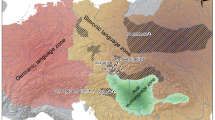Abstract
New forms of literary resource interpretation in geogarphy have come to the fore in recent years. However, representation has not kept pace with this interpretive advance. I explore the background of this idea, discuss its potential, and present an example of alternative representations using the writings of Michael Shaara and Robert Penn Warren.
Similar content being viewed by others
References
Aay, H.: Environmental themes in ecofiction: In the Center of the Nation and Animal Dreams. Journal of Cultural Geography 14.2, 65–85 (1994).
Adams, H.; Searle, L. (eds.): Critical Theory since 1965. Florida State University Press, Tallahassee 1986.
Barnes, T.; Duncan, J.: Writing Worlds: Discourse, Text, and Metaphor in the Representation of Landscape. Routledge, New York 1992.
Bauman, Z.: Postmodern Ethics, Blackwell, Oxford 1993.
Brosseau, M.: Geography's literature. Progress in Human Geography 18.3, 333–353 (1994).
Buttimer, A.: The Practice of Geography. Longman, London 1983.
Catton, B.: Gettysburg: The Final Fury. Doubleday, New York 1974.
Davis, R.; Schleifer, R. (eds.): Contemporary Literary Criticism: Literary and Cultural Studies. Longmann, New York 1994.
Duncan, J.; Ley, D. (eds.): Place, Culture, Representation. Routledge, London 1993.
Gitlin, T.; Hip deep in post-modernism. The New York Times Book Review, 6 November 1988.
Gregory, D.: Geographical Imaginations. Blackwell, Cambridge, MA 1994.
Harvey, D.: The Condition of Postmodernity. Blackwell, Oxford 1989.
Lamme, A.: The use of novels in geography classrooms. Journal of Geography 76, 66–68 (1977).
Lamme, A.: Geography and children's literature. Internationale Schulbuchforschung 11, 27–37 (1989).
Lamme, A.: American's Historic Landscapes. University of Tennessee Press, Knoxville, 1989.
Olsson, G.: The eye and the index finger: Bodily means to cultural meaning. In: Golledge, R.; Couclelis, H.; Gould P. (eds.), The Search for Common Ground, pp. 126–137. Santa Barbara Geographical Press, Goleta, CA 1988.
Quonian, S.: A painter, geographer of Arizona. Environment and Planning D: Society and Space 6, 3–14 (1988).
Reichert, D.: Writing around circularity and self-reference. In: Golledge, R.; Couclelis, H.; Gould, P. (eds.), The Search for Common Ground, pp. 101–125. Santa Barbara Geographical Press, Goleta, CA 1988.
Salter, C.; Lloyd, W.: Landscape in Literature. Association of American Geographers, Washington, DC 1977.
Shaara, M.: The Killer Angels. Ballantine, New York 1974.
Soja, E.: Postmodern Geographies: The Reassertion of Space in Critical Social Theory. Verso, London 1988.
Author information
Authors and Affiliations
Rights and permissions
About this article
Cite this article
Lamme, A.J. Speaking with the same voice: geographic interpretation and representation of literary resources. GeoJournal 38, 41–48 (1996). https://doi.org/10.1007/BF00209118
Issue Date:
DOI: https://doi.org/10.1007/BF00209118




